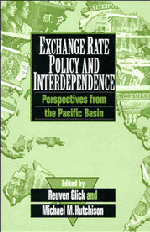Book contents
- Frontmatter
- Contents
- List of contributors
- Preface
- Exchange rate policy and interdependence
- 1 Overview
- I International financial market integration
- II Choice of exchange rate regimes
- 5 Exchange rate management: a partial review
- 6 Exchange rate policy and insulation from external shocks: the cases of Korea and Taiwan, 1970–1990
- 7 Trade price shocks and insulation: Australia's experience with floating rates
- 8 The role of the exchange rate in New Zealand monetary policy
- 9 Officially floating, implicitly targeted exchange rates: examples from the Pacific Basin
- III Intervention and sterilization policies
- IV Prospects for a yen bloc
- Index
8 - The role of the exchange rate in New Zealand monetary policy
Published online by Cambridge University Press: 04 May 2010
- Frontmatter
- Contents
- List of contributors
- Preface
- Exchange rate policy and interdependence
- 1 Overview
- I International financial market integration
- II Choice of exchange rate regimes
- 5 Exchange rate management: a partial review
- 6 Exchange rate policy and insulation from external shocks: the cases of Korea and Taiwan, 1970–1990
- 7 Trade price shocks and insulation: Australia's experience with floating rates
- 8 The role of the exchange rate in New Zealand monetary policy
- 9 Officially floating, implicitly targeted exchange rates: examples from the Pacific Basin
- III Intervention and sterilization policies
- IV Prospects for a yen bloc
- Index
Summary
Introduction
The objective of New Zealand monetary policy is clear: the Reserve Bank of New Zealand is to achieve and maintain price stability, defined as annual consumer price inflation of between 0 and 2 percent. This is perhaps the most clearly stated and single–focused objective for monetary policy of any country, but the Reserve Bank nonetheless faces the same control problem as other monetary authorities. How should it implement monetary policy to achieve its objective? Is there some intermediate target that will assist in achieving price stability – for instance, a monetary aggregate or the exchange rate?
The choice and use of such an intermediate target form the subject matter of this essay. The discussion is organized as follows. First, some background is provided concerning recent developments in New Zealand monetary policy and the existing monetary framework. Monetary policy is driven directly by the inflation target and is implemented primarily through control of the level of bank reserves via open market operations. In order to guide the setting of the target for bank reserves, inflationary influences (including the impact of monetary aggregate developments) are forecast and bank reserves are then set at a level that will yield an exchange rate band consistent with achieving the inflation target given the other inflationary influences. Thus, the exchange rate is used as a calibration device for setting monetary policy, but neither it nor a monetary aggregate is treated as a target in its own right.
- Type
- Chapter
- Information
- Exchange Rate Policy and InterdependencePerspectives from the Pacific Basin, pp. 176 - 197Publisher: Cambridge University PressPrint publication year: 1994
- 5
- Cited by



